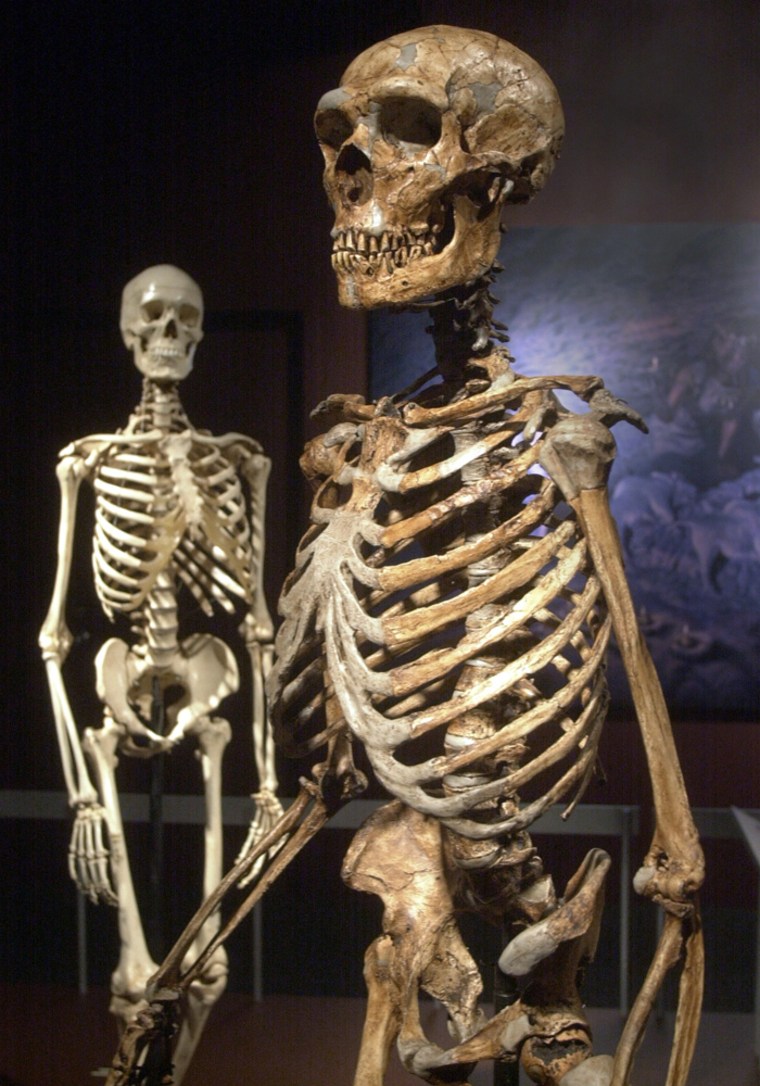Researchers in Germany have completed the first draft of the Neanderthal genome, more than 3 billion genetic building blocks that will shed new light on the ancient hominid as well as the origins of its closest relation — modern humans.
The draft covers about 63 percent of the roughly 3.2 billion base pairs in the Neanderthal genome. The team led by geneticist Svante Paabo has actually isolated 3.7 billion base pairs, but that includes many duplications.
Paabo, of the Max Planck Institute for Evolutionary Anthropology, said the Neanderthal genome will be an important tool for researchers tracing hominid evolution, and for those probing the origins of the genetic traits that make humans so dominant.
“It will help show what the differences are between them and us that allowed us to develop technology, to colonize the planet,” he told The Associated Press on Thursday before presenting his findings to attendees of an American Association for the Advancement of Science conference in Chicago by video uplink from Leipzig.
The announcement was planned to coincide with the 200th anniversary of Charles Darwin’s birth.
Gene expert Edward Rubin of the Lawrence Berkeley National Laboratory in Berkeley, California, is leading a separate project to sequence targeted segments of the Neanderthal genome. His work has shown that the Neanderthal genome is as much as 99.5 percent the same as modern humans. He said Paabo’s complete draft will let him compare segments and genes from his own research to a separate Neanderthal.
“We’ll look very carefully at the data they’ve generated, and it will tell us what areas we really want to look at,” Rubin said.
Comparative studies in the works
Other researchers are already planning comparative studies with genes known to influence speech and brain aging in humans. That work could rekindle a debate over whether early humans simply replaced Neanderthals, or whether the two may have interbred while their ranges overlapped in Europe more than 30,000 years ago.
Paabo, who presented DNA evidence in 1997 that Neanderthals were cousins rather than direct ancestors of modern humans, said his research suggests that if there was mixing between Neanderthals and modern humans, it has left minuscule traces in our genome. But he believes the new Neanderthal genome might allow researchers to investigate whether earlier human genes were passed on to the Neanderthal.
“We’re currently analyzing if we see evidence in the Neanderthal genome of contribution from human ancestors,” Paabo said. “That question I think is still totally open.”
Other researchers said the likelihood of contamination and the vast similarities between the two species would make it exceedingly difficult to pinpoint any genetic connection.
“This research is a great technical achievement in itself, but has little implication for the debate concerning a part-Neanderthal ancestry of Europe’s earliest modern humans,” Joao Zilhao of the University of Bristol in Britain wrote in an e-mail to the AP.
For 2½ years, Paabo ran minute samples of bone — the whole project has required just half a gram — through hulking half-million dollar machines that revealed DNA sequences.
The process was tedious and fraught with challenges. Much of the DNA in the bone had decayed over time, and it was difficult to distinguish what remained from the genetic material of bacteria that colonized the Neanderthal after death. Human handling at the excavation site in Croatia and at the laboratory also contaminated the sample.
Lots of data from a ‘crummy sample’
Paabo’s team studied places in the bone where molecules most often broke down over the centuries and used that data to rule out DNA that didn’t show similar degradation, meaning it probably belonged to bacteria. They sterilized their lab and attached a synthetic DNA tag to keep track of strands they believed to be genuine.
Geneticists and DNA researchers said the project’s success despite those challenges is its most significant achievement.
“What they’ve shown is it’s possible to get that much data from this old, crummy sample,” said Tom Gilbert, a geneticist at the University of Copenhagen in Denmark.
Many more runs will be necessary, Gilbert said, to check each pair by covering it multiple times before it’s clear which pairs are unique to the Neanderthal. Paabo hopes to cover each Neanderthal base pair 12 to 15 times in the years ahead.
In the meantime, scientists can compare smaller sections of Neanderthal DNA to data from completed genome projects on humans and chimpanzees.
Beth Shapiro, an ancient DNA specialist at Penn State University, said placing the three side by side will make it possible to determine what regions of our genome make us uniquely human.
“There are 35 million differences between chimps and us,” Shapiro said. “That’s a lot, so we don’t really know where to look. But this Neanderthal genome gets us that little bit closer.”
A three-way comparison will also allow researchers to investigate whether the Neanderthal inherited a certain trait from an ancestor closer to the chimpanzee or one closer to modern humans, Paabo said.
Recent work to map an extinct mammoth’s genome using hair preserved in permafrost raised questions about whether it might be possible to clone the mammal using its DNA sequencing as a blueprint. Paabo said because the Neanderthal DNA was scattered in imperfect fossils, the notion of cloning a Neanderthal was far-fetched.
“Starting from the DNA extracted from a fossil, it is and will remain impossible,” he said. “There is not really an improvement on current technologies that would make that possible.”
